|


| |
|
SORRY,
THIS PAGE IS UNDER CONSTRUCTION
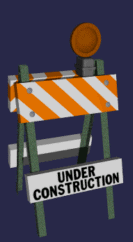
Museo dell'Opera del Duomo
|
 |
|
Detail Cantorie, Luca Della Robbia
1439 |
|
|
 |
|
Another detail
of the Della Robbia Cantorie |
|
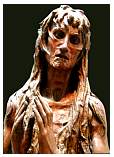 |
|
Magdelena
- Donatello 1455 |
|
|
The above three are among the most remarkable of the
works in this wonderful museum in a space built at the same time as the
Duomo for administrative offices. As works were changed in and on the
Duomo, they were stored here, and it has been open to the public since
1891. The interior is now a mind-popping, beautifully modern space
housing some of the most important works from the Renaissance.
Certainly for me the most memorable are the
cantorie panels - panels from a suspended choir loft. Two matching
lofts were originally installed in the Duomo, one by Donatello and one
by Luca Della Robbia. They were removed in 1688 in order to update
things for the wedding of Grand Prince Ferdinando. We are so lucky
that the Duomo conservators had the foresight to save all removed art
here. Of the two sets, it is the Della Robbia that thrilled and
delighted us. The exuberance of the youthful musicians is a joy to
behold, with details carved in the relief that are amazing, particularly
the young bodies under the flowing robes.
The two details above are among our favorites. The
youthful boy and girl on the left completely capture first love and the
transition from child to young man.
It is always a delight when you find something like
these cantorie when they are totally unexpected. In the city with
David and countless other famous works from the Renaissance that we so
eagerly anticipated, it was these Della Robbia carvings that set our
hearts to sing. Previously I had only know Della Robbia for the
polychromatic
highly glazed decorations (example
below) that have assumed his name, but I will now
remember him for these exquisitely carved cantorie.
Toy can view the full panels with the icons
below.




The third haunting image above is the stunning wooden statue of Mary
Magdalena by Donatello. It stands alone in the center of a gallery
and in contrast to every other image of Magdalena I have ever seen. Here
she is not a beauty, but a worn and tired woman who has spent her life
on the street and on her back. It defies the Renaissance ideals
and depicts a
verissimo
suggesting that it could have been carved today. |
Cappella Pazzi
Flippo Brunelleschi 1430-1446
|
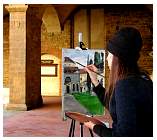 |
|
Cappella Pazzi |
|
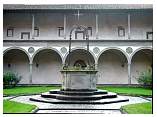 |
|
Chiostro
Grande, Bernardino Rossellino, 1453 |
|
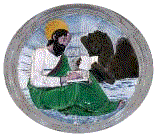 |
|
St. Mark Tondo, Luca Della Robbia |
|
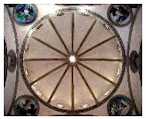 |
|
Interior Dome, Cappella Pazzi, Brunelleschi |
|
|
This beautiful space is so easy to
miss and such a lovely refuge that you must not. Just to the right
of the great Basilica of Santa Croce is a small door in the wall that
leads into a nice cloister with the justifiably famous Pazzi Chapel
designed by Brunelleschi, the same that designed the heroic dome on the
Duomo. Stepping through that little door provides a sanctuary from
the bustle of Florence. There is soft green grass, quite, and a
soothing sense of scale. The lovely facade of the chapel has a perfect
symmetry, and is idyllic at the end of the grassed cloister.

The small interior space is simply decorated. In the
pendentives are heroic tondos by Della Robbia depicting the four
Evangelists. These polychromatic reliefs are the kind of thing I
thought of when Della Robbia was mentioned until I saw his
cantorie. St. Mark, one of these
tondos, is above along with a straight-up view of the dome
showing all four of the tondos.
Beyond the chapel is a small passageway to a second
and truly beautiful space, Cloister 2, or Chiostro Grande, designed by
Rossellino. Here is architecture that begs you to contemplate.
Certainly you want to visit the monumental Basilica
to see the beautiful frescos and to give homage at the tombs of the
Renaissance greats Michelangelo, Machiavelli and Galileo. With
these icons you can view images of the Basilica and it's small Piazza
from the church:


|
Mercato Centrale
|
 |
|
Nerbone
in the Central Market |
|
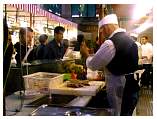 |
|
The paninaio preparing
the famous panino con la carne bagnato at
Nerbone |
|
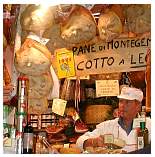 |
|
Andrea Perini at
Gastronomia Perini |
|
|
The Central Market in Florence seems like an indoor
extension of the bustling, outdoor market that extend for blocks from
San Lorenzo. The entire atmosphere feels like stepping into another,
much older generation. The building is massive and just looms out of the
bancarelle (stalls) crowded streets. It is a grand brick, glass
and iron structure with two floors of shops and stalls. I was
surprised to learn that it was built in 1874 (it seems quite modern) and
designed by Mengoni, who also brought us the great Galleria in Milan.
If you want to experience a bit of everyday Florentine life, you must
visit the Central Market.
Once inside it is all about the assault on the
senses. Upstairs are the vegetable and fruit vendors. Downstairs are the
meat and fish vendors and the gastronomia - food specialty stores
(what we think of as an Italian delicatessen). Here you will find lots
of things you will not see in Safeway. Italians believe every bit
of the animal should be used and have no problem with displaying animals
with their heads still intact or rabbit with the fur still on - in fact,
they insist that at least one paw be intact to make sure the carcass is
not a cat.
A colorful shop with fantastic salamis, cheeses, and every other
imaginable delicacy is Gastronomia Perini. Run by brothers Andrea
and Claudia, they are famous for their mostarde of orange, apple,
fig and more. You can visit the
Perini website and explore their offerings where on
the English version they call their mostarde Chutneys. They also
carry the delectable gigantic bright green olives stored in brine.
These are a treasure we always seek in Italy.
One place in the market that must not be missed is Nerbone, and
you must reserve one day for lunch there. It is not more than a large
counter with a half dozen tables against the wall across the isle.
Here is where the workers of the market eat, and the food is hearty and
genuine Florentine. Big bowls of pasta, perfect soups (ribollita
is great), all at very low prices. But the gastronomic main
attraction is the boiled beef sandwich: panino bollito. The
Nerbone boiled beef sandwich is a must on any visit to
Florence. It is fun to watch the paninaio (sandwich maker)
assembling these delicious offerings, which can be had plain or with
salsa verde
or peperoncino oil (very spicy) or both. Make sure you specify
carne, as there are other boiled meat sandwiches, and you could end
up with tripe.
Nerbone is so much more than just good food. Combined
with the market, it is la vera italia - where you will find the
real Italy. But, don't plan on your typical late Italian lunch. Nerbone
closes with the market at 2:00, and they start running out sooner.
 |
|
 |
|
Outdoor Market
bancarelle (stands)with
Central Market
on the left |
|
Second Floor Vegetable Stalls
showing the beautiful ironwork |
|
Perseus
Benvenuto Cellini,
1545
|
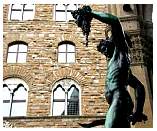 |
| Perseus
- PalazzoVecchio Backdrop |
|
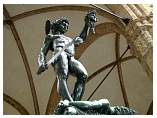 |
Perseus, Cellini,
Loggia dei Lanzi |
|
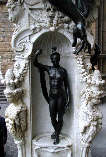 |
|
The beautiful and delicate detail of the Perseus
Base, Cellini |
|
|
| In my humble
opinion Benvenuto Cellini's statue of Perseus is one of
the most beautiful, elegant, and powerful statues ever created.
For me it works on so many levels. It's graceful form and
lines, |
| Bridges of the
Arno |
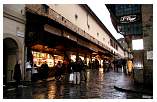 |
|
On the Ponte Vecchio
at Night |
|
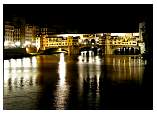 |
Ponte Vecchio
|
|
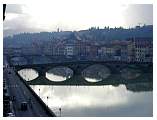 |
| Ponte alla Carraia |
|
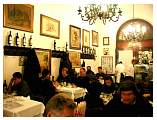 |
Antico Fattore
Via Lambertesca |
|
| |
| Some Nice tidbits |
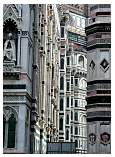 |
|
Duomo |
|
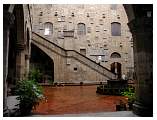 |
|
Courtyard of the Borgello |
|
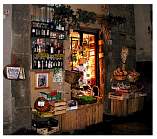 |
|
A Typical Store |
|
|
| |
|
|
|
|
http://www.oldandsold.com/articles07/travel-42.shtml
Perseus was born of
the god Zeus and the mortal Danae. Acrisius, the father of Danae,
had been warned by an oracle that the child of his daughter
would be his killer. Hence, Acrisius set the young child Perseus
adrift at sea with his mother. Floating to Seriphus, Perseus and
his mother were discovered by a fisherman and dispatched to
Polydectes, the king. Polydectes fell in love with Danae and,
considering Perseus an obstacle, sent him in quest of the head
of Medusa -- thinking that Perseus would be killed. Medusa, the
Gorgon, had once been a very beautiful woman, her hair being her
great glory. The end result of what was the mythological
equivalent of a catfight lost to Minerva, the equally beautiful
Minerva deprived Medusa of her beauty and changed her glorious
hair into hissing serpents. She became so hideous that any
living thing that looked directly upon her turned to stone. In
his quest to return to Polydectes with the head of Medusa,
Perseus was aided by Minerva and Mercury, receiving a shield and
winged shoes. Perseus arrived at the cave of Medusa, scattered
with stone figures of men and beasts. Rousing his inner courage
and cleverly using the reflection of the shield from Minerva to
deflect Medusa's direct gaze, Perseus severed her head and flew
back to Polydectes, eventually turning him to stone with the
Medusa head in response to his poor treatment of his mother and
the kingdom. As for his father, Acrisius, Perseus did eventually
kill him -- with an accidental discus throw at a contest.
Benvenuto Cellini was born in Florence in 1500. He was apprenticed
to a goldsmith at the age of 15.
At the age of 16, continual duelling and brawling caused him to be
exiled to Sienna. In 1523, he was prosecuted yet again for fighting. The
justice ruled that he be given the death penalty. Luckily for Cellini,
he managed to flee to Rome. There, he became a pupil working under
Michaelangelo. In 1527, he shot a constable of Bourbon and the Prince of
Orange. In addition to his criminal list, Cellini was accused of killing
a rival goldsmith. Ten years after the murder of the constable and the
prince, he was accused of embezzlement. After being thrown in jail, he
escaped with much skill to be foolishly caught and imprisoned again.
|
|
|